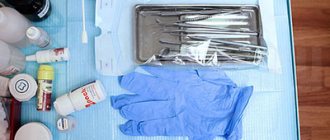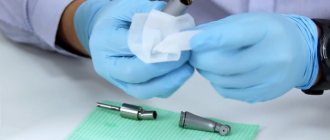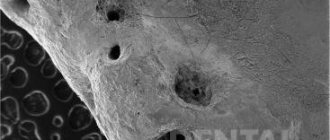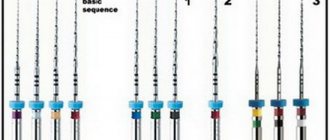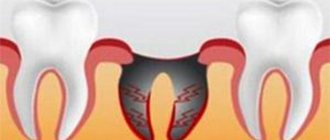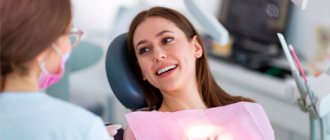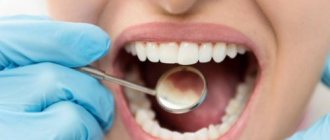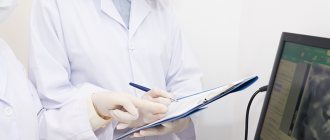Cleaning of premises and high-quality processing of medical instruments is the most important link in the chain of measures to prevent nosocomial infections (nosocomial infections).
Sanitation must be carried out systematically. The rules of SanPiN 2.1.3.2630-10 are legally established, which regulate the sequence and frequency of sanitary cleaning of premises and equipment in health care facilities.
Sanitation is a whole set of measures for cleaning surfaces from dust, visible dirt, blood, sputum, followed by disinfection with special means.
General requirements for compliance with sanitary standards
Today, the main requirement in dentistry is the use of disposable materials for patient treatment. Before the appointment, all auxiliary materials must be replaced, including gloves and a doctor’s cap. Reusable instruments must be removed from special sterilization bags that indicate the date and time of their sterilization.
Some patients are so eager to see a doctor that they want to enter the office immediately after the previous patient has left. They do not think that after seeing a patient, medical workers disinfect the office. Therefore, after one patient leaves, all surfaces with which he came into contact or could hypothetically come into contact are wiped with a disinfectant solution. Disposable instruments are disposed of in accordance with all sanitary standards. During the entire reception, the bactericidal recirculator lamp should be running, which can operate in continuous mode (without stopping).
Disinfection at the Domostom clinic
Disinfection of surfaces and floors in offices is carried out after each patient. To treat surfaces and saliva ejection systems, we use Aminaz Plus 0.4% solution. The working day ends with final cleaning. According to sanitary standards and in accordance with SanPin, our dentistry carries out general cleaning monthly (weekly).
In Domostom, instead of conventional quartz lamps, new-generation bactericidal recirculators “Dezar-3” are installed.
We care about the environment: medical waste is disposed of in special containers. Everything is documented.
Accounting documentation is completed daily.
Disinfection and cleaning measures
Instruments that have come into contact with the patient's saliva are a source of increased danger. Therefore, immediately after use, the instrument is loaded into a container with a disinfectant and cleaning solution. Then, it is processed in a thermal disinfector.
The next stage of processing is cleaning. It helps remove remnants of medications and fatty contaminants. The best method of cleaning is mechanical processing in special machines. This is the only method that allows complete removal of saliva and blood residues from the surfaces of instruments.
Pre-sterilization cleaning of instruments
All instruments are kept in a disinfectant solution of 3% “Aminaz Plus 0.4%” for 15 minutes, followed by mechanical treatment. Burs, files, brushes and other instruments are soaked for 30 minutes in Desco Drill solution. Next, the instruments are immersed in an ultrasonic bath for 15 minutes - this guarantees the quality of pre-sterilization cleaning.
Quality control of pre-sterilization cleaning is carried out by performing azopyram and phenolphtolein tests. Clean instruments are packaged in individual craft bags “Cleene Pack”, “PicPack”, “Euronda”, “Sigma”. Sterile bags are opened only when the patient is seen by a doctor.
Every six months, the solutions are changed from “Aminaz Plus 0.4%” to “BabyDez Ultra”, “Desco Drill” to “Rotasept”.
Sterilization
Sterilization is the final stage of processing medical instruments. There are two main methods - steam and air. Steam sterilization uses:
- autoclave;
- wet sterilizer;
- hot steam sterilizer.
This method works using steam from distilled water under high pressure at temperatures up to 135o.
Air sterilization is carried out using a dry-air sterilizer or a dry-heat oven. The air temperature in such devices reaches 180°.
Sterilization takes place in several stages:
- steam treatment;
- sterilization;
- drying.
The entire procedure takes approximately 1.5 hours. After this, each instrument is placed in a disposable sterilization bag, on which the date and time of packaging is written. Sterility in such bags is maintained for about six months.
Methods for sanitizing instruments in the Da Vinci aesthetic dentistry studio
Our clinic is a modern dental center. And we approach the issue of patient safety thoroughly. Therefore, cabinet processing necessarily includes the following steps:
- disinfection of all surfaces in the office before each patient;
- placing all instruments related to the patient in a special sterilization bag;
- issuing disposable “clothing” to those coming for treatment - a disposable napkin, a cap;
- the bactericidal lamp operates throughout the entire appointment;
- sterilization of instruments after each use;
- The doctor changes gloves and cap after each appointment; gloves are also changed if the doctor leaves the patient. In our clinic, it is customary to do this in front of the patient so that he has no doubts about the complete safety of the entire treatment.
- During X-ray procedures, the device’s sensor is placed in a disposable bag, which is immediately thrown away after use.
We care about the health of our patients and strive to ensure that treatment is as safe as possible.
Add a comment
Leave your comment
Sterilization of dental instruments
Today, almost every person who crosses the threshold of a dental institution knows that everything the dentist touches must be as clean as possible, treated according to all the rules from microorganisms, so the presence of modern sterilization equipment in the clinic has become a guarantee of peace of mind for the patient and, as a result, a fact , increasing the prestige of this clinic. Thus, when choosing a dental institution, it is recommended to pay attention, first of all, to the degree of its equipment for sterilization and disinfection of medical instruments, and only secondly to the merits of the staff and the price of the services provided.
In every dental office, regardless of its functional focus, instruments and materials must be stored in sterile conditions. Usually this is a sterile table set according to all the rules or sets of sterile instruments sealed in bags. Ideally, treated instruments should be stored in sterile, disposable packaging and opened only in the presence of the patient. The presence of sterilely packaged tips and instruments in a dental clinic tells the patient about the level of responsibility of this medical institution and the preservation of his health.
Any dental office must be equipped with a bactericidal ultraviolet irradiator, which is used to carry out quartz treatment. You should also disinfect surfaces in your dental office, including equipment, faucets, and door handles.
Anti-infective protection of a doctor and his assistant during patient visits is largely determined by the correct use of disposable and reusable clothing, caps, gloves, safety glasses, and hand hygiene products that have bactericidal and antiviral effects. Despite the fact that medical personnel always work in disposable sterile gloves, careful hand cleaning is necessary, since a huge number of microorganisms accumulate on them.
So, all instruments intended for medical purposes must be subjected to sterilization, a complex process of destroying all types of microbial flora and viruses using physical or chemical agents. Sterilization can be steam, dry heat and gas. Currently, steam sterilization (in autoclaves) is the preferred method of eliminating the risk of cross-infection from contaminated equipment, recommended by the World Health Organization and the Center for Disease Control for healthcare workers.
For reliable sterilization of dental instruments, advanced clinics use class “B” autoclaves, which allow sterilization of any medical instruments, linen, dressings and where all phases are controlled automatically, there is an interface with a printer and a personal computer for logging the entire process. Moreover, when sterilizing dental handpieces that have a complex structure of internal channels, only class “B” autoclaves are allowed.
Class “B” autoclaves can sterilize all types of medical instruments and materials: solid, hollow, porous, individually or double-packed of any type. They are equipped with a pre-vacuum cycle and vacuum drying at the end of the sterilization process, which reliably eliminates all infections and does not damage the surface of autoclavable instruments.
You can find out about the sterilization equipment of ProfiSmile dentistry here
Basic sterilization methods
Currently, dentistry uses several modern methods of antiseptic and sterilization treatment, which makes it possible to virtually reduce any risk of transmission of infections and viruses to zero. The main ones are described below:
- the mechanical method is wet cleaning of premises, washing of medical staff uniforms and other textile products intended for reusable use, as well as regular ventilation of the premises of the dental center strictly according to the established schedule,
- biological – cleaning surfaces using specialized antimicrobial agents. Weak disinfectant solutions may be used that are not capable of destroying individual strains of bacteria, therefore this treatment is considered superficial and is not suitable for all products,
- physical – processing of tools at high temperatures. This is one of the fairly effective methods, which, however, cannot be used for products not made from heat-resistant materials. This thermal sterilization is carried out dry or steam,
- chemical sterilization - aggressive chemical solutions are used for highly effective disinfection. A proven and guaranteed method of destroying most types of viruses and bacteria. This method is used for products that are in direct contact with wound surfaces and are prohibited from being processed at high temperatures. This cold processing is applicable to products made of plastic, rubber and glass,
- microwave – used for processing products belonging to the categories of low and medium infectious risk. Disinfection is carried out by exposing them to ultraviolet rays. This allows for high-quality and quick disinfection of surfaces that do not come into direct contact with mucous membranes and open wounds.
“Now all dentists take the sterilization of instruments very seriously, especially since most of them are already disposable. The doctor takes them out from a sealed package right in front of your eyes. All these are stories about the risk of infection. Perhaps earlier there was a certain probability of catching something, but definitely not now. I talked to my dentist about this about 5 years ago, he explained everything to me in detail.” Lilya, from correspondence on the 32top.ru forum
Above, we reviewed the methods that are used today to disinfect products in dental practice. Now let's move on to considering the sterilization algorithm.
General purpose dental kits
An important condition for disinfection is to ensure that instruments are not contaminated until the moment of use. For this purpose, medical institutions use special storage rooms for sterile products. These are hermetically sealed cabinets equipped with quartz emitters. To maintain sterility, healthcare workers are guided by the following principles:
- processing of individual dental kits in 3 stages - disinfection, PSO (pre-sterilization cleaning) and sterilization. At the end of the process, the instruments are washed in sterile water (disinfectant solution) and transferred into containers with distilled water using sterile tweezers. Products are stored in closed containers for no more than 3 days, on a sterile table for no more than 12 hours1,
- The tweezers are stored dried in a special tray, covered with a sterile napkin. Each of these tweezers can be used for no longer than 2 hours, the puster (a tool for drying carious cavities) and brush holders are disinfected after each patient,
- gutta-percha points and brushes for restoration are intended for single use,
- carpule metal injectors are processed in 3 stages described above, suction systems are disinfected 2 times a day - after the first shift and at the end of the day,
- tips for saliva ejectors are intended for single use, they must be disinfected before disposal,
- glass slides (for mixing paste, cement and other materials) are intended for single use,
- spittoons - after each patient they are immersed in a disinfectant solution.
Processing of individual dental kits.
For disinfection treatment in dentistry, specialized tools and equipment approved by the Ministry of Health of the Russian Federation are used. The issue of security in general is given particular importance. Compliance with honey institutions established requirements virtually reduces to zero any risk of transmission of infections and viruses between patients and medical staff. Therefore, when you turn to a dental center for help, you don’t have to worry about your health.
1Baranova I., Larionov V. Some aspects of the use of drugs and disinfectants in the security system, 2005.

